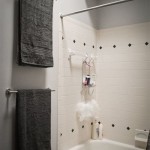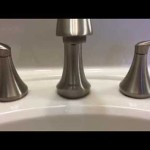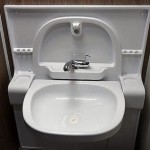How To Install a Bathroom Sink with Pedestal
Installing a bathroom sink with a pedestal is a home improvement project that can significantly enhance the aesthetic appeal of a bathroom. While it may seem daunting, with careful planning, the right tools, and attention to detail, the installation can be successfully completed by a homeowner with intermediate DIY skills. This article provides a comprehensive guide to the process, outlining each step for a standard pedestal sink installation.
Before beginning, it is crucial to understand the plumbing requirements in the specific location. This includes the placement of supply lines for hot and cold water, as well as the drainpipe. Also, familiarize yourself with local plumbing codes to ensure the installation meets all regulatory requirements. Ignoring these codes could result in fines or necessitate future rework.
Key Point 1: Preparation and Gathering Materials
The first crucial step involves meticulous preparation. This includes gathering all the necessary tools and materials. Rushing into the installation without proper preparation can lead to delays, frustration, and potentially damage to the sink or plumbing.
Tools Required:
*Adjustable wrench: Essential for tightening and loosening plumbing connections.
*Basin wrench: Specifically designed for working in tight spaces under the sink.
*Pipe wrench: Used for gripping and turning pipes.
*Level: To ensure the sink and pedestal are perfectly level.
*Tape measure: For accurate measurements and placement.
*Drill with appropriate drill bits: For drilling into the wall for mounting hardware.
*Screwdriver (Phillips and flathead): Various sizes may be needed for different screws.
*Pencil: For marking drilling locations and measurements.
*Caulk gun: For applying sealant around the sink and pedestal.
*Stud finder: To locate wall studs for secure mounting.
*Safety glasses: To protect eyes from debris.
*Gloves: To protect hands.
Materials Required:
*New pedestal sink: Including the sink basin and pedestal base.
*Faucet: Choose a faucet compatible with the sink's hole configuration.
*Drain assembly: Pop-up drain or similar style.
*Supply lines: Flexible supply lines to connect the faucet to the water shut-off valves.
*P-trap: A curved pipe that traps debris and prevents sewer gases from entering the bathroom.
*Tailpiece: A pipe connecting the drain assembly to the P-trap.
*Mounting hardware: Screws, anchors, and brackets for securing the sink to the wall.
*Plumber's putty: Used to create a watertight seal around the drain assembly.
*Silicone caulk: Used to seal gaps and prevent water damage.
*Teflon tape: Used to seal threaded plumbing connections and prevent leaks.
Once all tools and materials are gathered, it is important to turn off the water supply to the bathroom sink. Locate the shut-off valves under the existing sink and turn them clockwise until closed. If there are no shut-off valves present, the main water supply to the entire house will need to be shut off. After turning off the water, open the existing faucet to relieve any residual pressure in the lines. Place a bucket under the existing plumbing connections to catch any remaining water when disconnecting the old sink.
Next, remove the old sink. Disconnect the water supply lines and the drainpipe. Be prepared for water to spill out during this process. Once the connections are disconnected, remove the old sink from the countertop or mounting brackets. Clean the area thoroughly to remove any debris or old sealant. Ensure the wall is clean and dry before proceeding with the installation of the new pedestal sink.
Key Point 2: Installing the Faucet and Drain Assembly
Before installing the sink basin on the pedestal, it is often easier to install the faucet and drain assembly. This step can be more challenging once the sink is mounted due to limited access. Follow the manufacturer's instructions for both the faucet and drain assembly.
Installing the Faucet:
Insert the faucet into the designated holes in the sink basin. Depending on the faucet design, it may require tightening nuts or screws from underneath to secure it in place. Ensure the faucet is properly aligned and securely fastened. Connect the water supply lines to the faucet according to the manufacturer's instructions. Teflon tape should be used on the threaded connections to ensure a watertight seal.
Installing the Drain Assembly:
Apply a ring of plumber's putty around the underside of the drain flange. Insert the drain flange into the drain opening in the sink basin. From underneath the sink, attach the drain body and tighten the nut to secure the drain flange in place. The excess plumber's putty should be removed with a putty knife or a damp cloth. Connect the tailpiece to the drain body. This will be the connection point for the P-trap later in the installation.
After installing the faucet and drain assembly, carefully inspect all connections for leaks. Turn on the water supply briefly to check for any drips or seepage around the faucet and drain. If any leaks are detected, tighten the connections or reapply plumber's putty or Teflon tape as needed.
Key Point 3: Mounting the Sink and Pedestal
With the faucet and drain assembly installed, the next step is to mount the sink basin and pedestal. Pedestal sinks typically require wall mounting for stability, in addition to the support provided by the pedestal base. It is critical to locate the wall studs and use appropriate mounting hardware to ensure the sink is securely attached to the wall.
Positioning the Sink and Pedestal:
Place the pedestal in the desired location. Position the sink basin on top of the pedestal. Check the alignment and ensure the sink is level using a level tool. Mark the location of the mounting holes on the wall. It is essential to use a stud finder to locate the wall studs behind the drywall. If the mounting holes do not align with the studs, use appropriate anchors designed for drywall or other wall materials.
Drilling and Mounting:
Drill pilot holes at the marked locations on the wall. Be sure to use a drill bit appropriate for the wall material. Insert the mounting hardware, such as screws and anchors, into the pilot holes. Carefully lift the sink basin and align the mounting holes with the screws or anchors. Tighten the screws to secure the sink to the wall. Do not overtighten the screws, as this could damage the sink or the wall.
Connecting the Plumbing:
Connect the water supply lines to the shut-off valves. Ensure the connections are tight and secure to prevent leaks. Use Teflon tape on the threaded connections for added protection. Install the P-trap to the tailpiece of the drain assembly. Align the P-trap with the drainpipe in the wall and connect it securely. Tighten all connections to prevent leaks.
Final Adjustments and Sealing:
Once the sink is mounted and the plumbing is connected, perform a final check to ensure everything is properly aligned and level. Turn on the water supply and check for any leaks around the faucet, drain, and supply lines. If any leaks are detected, tighten the connections or reapply plumber's putty or Teflon tape as needed. Apply a bead of silicone caulk around the base of the pedestal where it meets the floor, and around the back edge of the sink where it meets the wall. This will seal any gaps and prevent water damage. Smooth the caulk with a wet finger or a caulk smoothing tool for a clean and professional finish.
After the silicone caulk has dried completely, the installation is complete. The new pedestal sink should be securely mounted, and all plumbing connections should be leak-free. Dispose of all packaging materials and clean the area thoroughly.
Regular maintenance is essential to prolong the life of the pedestal sink and prevent plumbing issues. Periodically check the plumbing connections for leaks and tighten them as needed. Clean the sink basin and pedestal regularly to prevent the buildup of soap scum and mineral deposits. Avoid using abrasive cleaners, as they can scratch the surface of the sink. With proper care and maintenance, a pedestal sink can provide years of reliable service and enhance the beauty of the bathroom.

Here S How Install A Bathroom Pedestal Sink
Pedestal And Wall Mount Bathroom Sinks

How To Install A Pedestal Sink W Detailed Pictures Bestlife52

How To Fit A Bathroom Sink Diy Guides Victorian Plumbing

How To Install A Pedestal Sink The Home Depot

How To Install A Pedestal Sink And Faucet By Home Repair Tutor

Simple Ways To Install A Pedestal Sink 12 Steps With Pictures

How To Install A Bathroom Sink Or Basin Victoriaplum Com

How To Install A Pedestal Sink

How To Install A Pedestal Sink Elevate Your Bathroom
Related Posts







